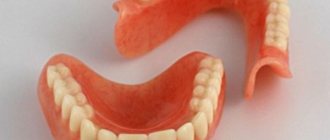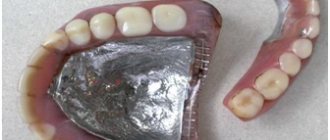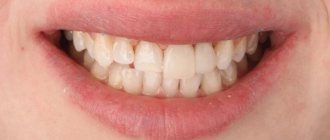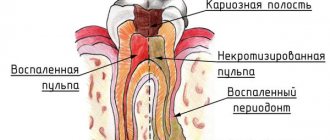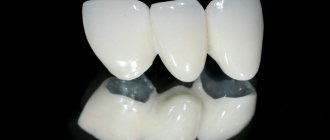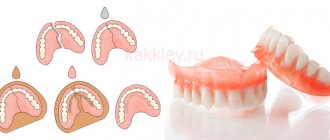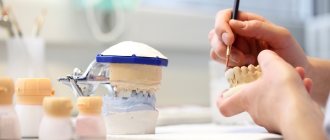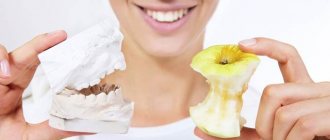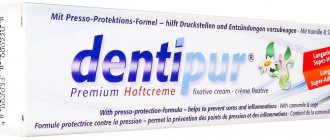June 26, 2017
Missing tooth
Many patients mistakenly believe that tooth extraction is the final stage of treatment. But after all, the tooth must be restored. Firstly, to preserve the aesthetics of the smile and the psychological comfort of the patient. Secondly, to prevent bone tissue reduction that occurs in the first months after tooth loss. Thirdly, to preserve the bite, because if even one tooth is missing, the rest in the row shift towards the empty space. And when a large number of teeth are removed, the shape of the face even changes, wrinkles appear - the person looks much older than his age.
Today, there are three main methods of restoring teeth removed along with the root. And the good news is that each patient will be able to choose an option that suits him in terms of quality and price.
Removable prosthetics for tooth restoration
The photo shows removable dentures
Pros
- cheap
Minuses
- relative aesthetics
- poor comfort
- you need to use fixing agents
- the prosthesis does not protect against bone atrophy
Removable dentures are the most affordable option for tooth restoration. They are mainly used in the absence of a large number of teeth or replacement of a full row, but it is also possible to install a structure in place of 1-2 teeth. The dentures are a plastic base that has a pinkish tint to match the color of the gums, as well as several dental crowns. If the prosthesis is attached to living teeth, it also contains hooks: plastic (for soft dentures) or metal (clasp denture, which has an additional metal base - it is used only for partial dentures).
Modern dentures are created from various materials: hard or soft plastics, nylon, polyurethane, acrylic resins. Soft and elastic dentures are characterized by increased flexibility and comfort; they fit tightly and cause virtually no discomfort. Plate dentures made of hard plastic are less comfortable, but their cost is 2-3 times lower than modern flexible models. Some of the most popular options for removable dentures include nylon, polyurethane, acrylic, as well as Acry-Free and Quadrotti.
Of course, not every patient, especially young and active ones, will decide to install removable dentures. But if the issue is price, the only choice is definitely removable structures. You shouldn’t be afraid of them - modern products are quite convenient and comfortable, and they also look quite aesthetically pleasing. Of course, you will have to get used to them, and over time they will not fit very tightly to the gums and teeth - you will have to use creams and gels as additional fixation.
Watch the video: nylon denture
Recovery tabs
Restorative inlays are used for damage to premolars and molars. They are used as an alternative to composite fillings when more than 30% of the tooth is damaged. In essence, inlays are microprostheses. They are identical to the patient’s bite and represent a one-piece structure that is simultaneously attached to several molars using special cement. They are made by a dental technician using impressions.
Restoration with inlays consists of several stages :
- Preparation of a damaged cavity.
- Taking impressions and color selection (for ceramic inlays).
- Making the insert takes from a week to two.
- Fitting and installation of a microprosthesis.
Important! It is impossible to install the insert on incisors and canines due to the cutting surface. To secure the microprosthesis, a large horizontal area is needed.
The inserts are made from an alloy of metals, metal-ceramics and ceramics. Microprostheses made of ceramics are considered the most reliable. Their cost varies between 15,000 rubles.
Inlays are made according to individual impressions.
Permanent bridge
Photo: bridge prostheses
Pros
- relatively low cost
- durability
- reliable fixation
Minuses
- teeth grinding required
- the supporting teeth under the crowns are destroyed
- the jawbone shrinks in volume
A bridge or dental bridge is a structure consisting of several crowns. The central one serves to replace the removed tooth, the others are used as a support. As a rule, the bridge is fixed on your own teeth, which are ground down quite heavily to cover it with a crown. This is one of the most important disadvantages of bridge prosthetics. The supporting teeth are destroyed over time, since the maximum load falls on them. In addition, a dental bridge does not stop bone tissue atrophy, since it restores only the top of the tooth without the root - and this is not physiological.
However, in use, dental bridges show good resistance to heavy chewing loads and durability (they serve flawlessly for 15 years or more). Metal ceramics and zirconium dioxide are mainly used as materials for prostheses.
Watch the video: Dental bridges
Composite restoration
Composites are photopolymer materials. They are applied layer by layer to the damaged area and harden under the action of the light flux emitted by the photopolymerizer. They consist of epoxy and acrylic resins, silane and inorganic filler.
Important! Due to their high strength, the possibility of individual color selection and high restoration accuracy, photopolymers are used today in every dentistry.
Composite materials are applied in layers.
Composite restoration is used when no more than 30% of the tooth is damaged. The procedure takes an average of half an hour and is carried out in one visit:
- Cleansing the cavity from carious damage and expanding it.
- Treatment of the prepared area with antiseptics and installation of an insulating gasket.
- Covering a tooth with a filling.
- Grinding and polishing.
Dental implantation
Photo: tooth implantation
Pros
- tooth restoration including crown and root
- durability
- the best aesthetics
- normalization of natural processes in bone tissue
Minuses
- expensive
- a large list of contraindications
- need to find a professional doctor
Dental implantation is the most natural option for tooth restoration. If they are missing a little, then one implant is installed under one tooth. If 3 or more teeth are missing, two or more implants will be required, and a bridge will be fixed on them. But if all the teeth in a row are missing, the doctor will install from 4 to 8-10 implants, evenly distributing them over the jaw. You can attach both a dental bridge and a removable denture to them (it is fixed securely and should only be removed periodically for hygiene procedures).
An implant can be installed in two ways: after tooth extraction (3-4 months must pass until the bone tissue is restored), or simultaneously with tooth extraction (of course, this is not always possible - often a diseased tooth requires emergency extraction from the socket, but you can figure it out and have time prepare). The second option, of course, is more preferable, since the doctor’s work is reduced and there is no need to perform several surgical operations. Often, the implant can even be loaded with a prosthesis immediately – literally within a week.
If, when restoring a tooth after extraction, it is not possible to install an implant at the same time as removing the tooth, you will have to perform an independent operation. To do this, the gums are peeled off or punctured (depending on the implantation method), a hole is drilled in the bone tissue and the implant is placed in the prepared bed. Next, the metal root is left for 3-6 months - the main thing is to reduce the pressure on it so that it takes root and becomes one with the bone tissue. But you won’t have to walk without teeth – during this time the patient will be fitted with temporary removable dentures.
Dental implantation is a more expensive method of tooth removal, but also the most natural. After all, not only the crown (top of the tooth) is restored, but also its root. This means that the entire dental system will function in its usual, natural way. Dental implantation will cost 2-3 times more than installing conventional dentures. But this is an investment in the future, since the service life of implants and prostheses is 15-20 years or more, and if the crown breaks, it can easily be renewed without replacing the artificial root.
Remember that it is necessary to restore extracted teeth - to maintain your bite, the ability to chew food and, most importantly, your own psychological comfort. Be sure to consult a dentist and, together with your doctor, select the most optimal prosthetic option.
Watch the video: 5 methods of dental implantation
Notice
: Undefined variable: post_id in
/home/c/ch75405/public_html/wp-content/themes/UltraSmile/single-item.php
on line
45 Notice
: Undefined variable: full in
/home/c/ch75405/public_html/wp-content /themes/UltraSmile/single-item.php
on line
46
Rate this article:
( 2 ratings, average: 5.00 out of 5)
implantation, prosthetics
Consulting specialist
Kirichenko Vladimir Erikovich
Doctor rating: 9.5 out of 10 (4) Specialization: orthopedist Experience: 16 years
Defects in the crown of teeth
The program is focused on improving the skills of doctors through distance learning, where students will be able to master new technologies in treating patients under the guidance of practicing teachers.
After completing the educational cycle, doctors will receive 36 points in the CME system and a standard certificate. Contents Job responsibilities of an orthopedic dentist Stages of manufacturing pin teeth Materials for making crowns Types of anchors and their characteristics APK and PP in the CME resource Training under the program “Defects of the coronal part of teeth” Curriculum
Job responsibilities of an orthopedic dentist
The doctor’s activities must comply with the professional standard, which was approved by order of the Ministry of Labor and Social Protection of the Russian Federation dated May 10, 2016 No. 227n “Professional standard of a dentist.”
According to this document, an orthopedic dentist must perform professional labor functions, which include: conducting a comprehensive orthopedic examination, prescribing and monitoring non-drug or medicinal treatment methods, developing and implementing individual treatment and prevention programs, carrying out sanitary and anti-epidemic measures, providing medical care if necessary.
According to the legal document, the orthopedic dentist must know:
- laws of the Russian Federation, acts that regulate labor activity in medical institutions;
- methodological documentation that regulates the work of medical institutions;
- basic rules for providing medical and medicinal assistance to the population;
- orthopedic dentistry as a separate type of clinical discipline;
- preventive methods, diagnostics and rules for patient rehabilitation;
- drawing up a plan for dental services and activities;
- control of own service;
- maintaining all reporting and documentation;
- rules and regulations of labor protection, industrial sanitation, safety and fire protection;
- compliance with rules within a medical organization.
In addition, there are a number of job descriptions and responsibilities that a specialist must perform:
- according to his specialty and qualification category, the orthopedic doctor provides medical care using modern methods;
- in accordance with the plan and standard of care, the doctor chooses treatment tactics;
- analyzes the scope of the patient's upcoming examination as quickly as possible. At the same time, these manipulations should not affect the accuracy of the diagnosis;
- manages junior or paramedical staff;
- controls the implementation of medical procedures, the operation of medical technical equipment and instruments;
- complies with safety regulations;
- carries out instructions and instructions from management on time and accurately;
- complies with labor protection, industrial sanitation and safety regulations.
Stages of manufacturing pin teeth
Teeth pins are manufactured in factories and are used by dentists in the form of a porcelain crown with a pin. The production of such material occurs in several main stages:
- the first stage is the preparation of the subgingival part of the root: grinding off the vestibular side of the root to the level of the gums for aesthetic purposes and leveling the root plane;
- the second stage is expansion of the root canal. To do this, a pin is made to the length of the prepared root canal so that the structure completely covers the entrance, and the tip of the pin rests against the material. After this, the tooth is selected by color, size and other aesthetic aspects;
- in the last stage, the pin remains in the root canal. For an orthopedist, this means reducing the likelihood of errors during manipulations when installing structures. Then the root, crown and structure are treated with alcohol, and at the end the entire pin is cemented.
The crown has holes along the diameter of the pin. The weak part of this design is the removal of part of the hard tissues of the tooth, which can lead to corrosion and de-cementation due to the lack of reliable isolation of the root canal.
Materials for making crowns
In order to produce durable structures for prosthetics, namely crowns, the following alloys are used:
- gold 900 (Au - 90%; Ag - 4%; Cu - 6%). This is a yellow alloy, resistant to corrosion, which has high ductility and viscosity, fluidity in the molten state, and is easy to stamp. However, the disadvantage of this material is its low strength in a stamped crown;
- gold 750 (Au - 75.0%; Ag - 8%; Cu - 7.8%; Pt - 9.0%). It is yellow, but less characteristic of gold, since it contains Pt. Pt and Cu. Thanks to these elements, the alloy is harder and more elastic, and is also not subject to processing under pressure;
- steel stainless steel 1XI8H9T, which provides corrosion resistance, ductility is imparted by Ni.
- EI95 alloy is used for casting; fluidity is ensured by 2.5% Si. The disadvantage of the material is shrinkage during casting and low tensile strength.
Types of anchors and their characteristics
There are several main types of cylindrical anchors:
- VLOCK (Komet). This type of anchor is responsible for restoring a tooth with a damaged crown. The materials can also be used to make temporary teeth;
- SCREWPOST. Thanks to this anchor, there is a minimal increase in the diameter of the intra-root part of the system;
- RADIX-ANKER (Maillefer). The heads of this anchor look like parallel petal-shaped plates that surround a cylindrical axis;
- CYTCO (Maillefer);
- FLEXI-POST system. FLEXI-POST posts are made of titanium, have a long and thick retention head, have a screw thread and are self-screwing to create their own thread in the dentin. They are equipped with annular projections exactly adapted to the centering calibrated hole. This system has the best retention and at the same time reduces root tension;
- IKADENT endocanal pins. Expansion of the root canal with simultaneous creation of a direction for the pin is carried out using through drills;
- COLTENE/WHALEDENT. The ParaPost XFT system provides better fixation of the core material. Compared to previous systems (ParaPost and ParaPost Plus), resistance to torque is improved by 47% and resistance to lateral forces is improved by 68%. The ParaPost Drills kit is recommended for root canal preparation.
APK and PP in the CME resource
According to the order of the Ministry of Health of Russia No. 707n, each medical worker, in order to continue his activities, is required to obtain a higher education and complete a residency or internship, but over the next years he must improve his qualification category. All this is subsequently recorded by the accreditation procedure. However, thanks to new systems, doctors can use distance learning technologies.
Thus, the CME portal is a new form of advanced training for medical workers. Continuous medical education that a specialist receives within the framework of this resource is distinguished by the ability to build a personal learning path, which ensures the acquisition of knowledge, skills and competencies that meet the needs of specialists
Previously, healthcare workers were required to undergo continuing education training every 5 years in order to accumulate the appropriate number of hours to obtain certification. However, now there is an active implementation of the CME system, the transition to which was initiated by the Ministry of Health of the Russian Federation in 2020. According to this resource, you need to accumulate 250 hours in 5 years, and there is a set minimum of 50 points per year.
Using the programs presented on the CME portal, you can obtain access to the accreditation procedure, where, in addition to practical skills, the portfolio of specialists is also assessed.
The Academy of Advanced Training and Professional Retraining provides its programs for advanced training of dentists on the continuing education resource. APKiPP is the official provider of CME, therefore, all educational programs are developed by specialists in the medical field. In order to select a curriculum, students must be registered in the system, and then complete the following steps:
- in your personal account you need to select the “My Plans” tab;
- then, in order to add an educational cycle, you need to go to “Add elements”;
- in the line that appears on the screen, you need to indicate the name of the educational organization, in this case, AIC and PP. It is through it that you can quickly find and select the “Defects of the crown of teeth” program;
- in the drop-down menu you can familiarize yourself with the cost, curriculum of the program, and also create a training cycle.;
- The final stage is downloading the application form, filling it out and sending the application to the Academy’s email.
Training in the program “Defects of the crown of teeth”
The Academy provides training for medical specialists through the use of the latest remote technologies, which allows students not to interrupt their professional activities in a medical institution. Consequently, doctors from any region of the Russian Federation can begin the educational cycle.
Classes are conducted on the Moodle learning platform, where all Academy programs are located. Educational materials include the study of several disciplines, the lecture material of which is stored in the student’s personal account. There is also access to an electronic library, which presents modern articles and journals on a topic or area of interest. In your personal account you can familiarize yourself with:
- video lectures;
- video tasks;
- online seminars;
- webinars;
- practical tasks;
- rating system.
All exams and tests are implemented in electronic testing format. After completing the training, you receive a standard certificate and guaranteed 36 points in the CME resource for filling out a portfolio and further admission to accreditation.
